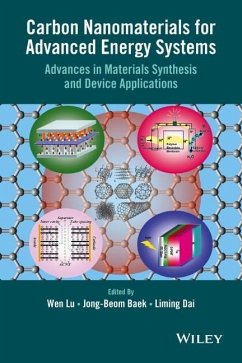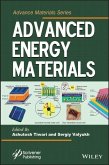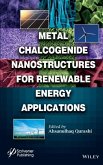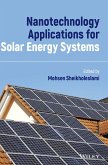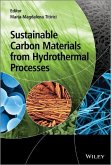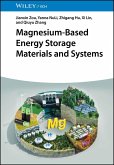Carbon Nanomaterials for Advanced Energy Systems
Advances in Materials Synthesis and Device Applications
Herausgegeben von Lu, Wen; Baek, Jong-Beom; Dai, Liming
Carbon Nanomaterials for Advanced Energy Systems
Advances in Materials Synthesis and Device Applications
Herausgegeben von Lu, Wen; Baek, Jong-Beom; Dai, Liming
- Gebundenes Buch
- Merkliste
- Auf die Merkliste
- Bewerten Bewerten
- Teilen
- Produkt teilen
- Produkterinnerung
- Produkterinnerung
With the proliferation of electronic devices, the world will need to double its energy supply by 2050. This book addresses this challenge and discusses synthesis and characterization of carbon nanomaterials for energy conversion and storage.
Addresses one of the leading challenges facing society today as we steer away from dwindling supplies of fossil fuels and a rising need for electric power due to the proliferation of electronic products Promotes the use of carbon nanomaterials for energy applications Systematic coverage: synthesis, characterization, and a wide array of carbon…mehr
Andere Kunden interessierten sich auch für
![Advanced Energy Materials Advanced Energy Materials]() Advanced Energy Materials243,99 €
Advanced Energy Materials243,99 €![Metal Chalcogenide Nanostructures for Renewable Energy Applications Metal Chalcogenide Nanostructures for Renewable Energy Applications]() Metal Chalcogenide Nanostructures for Renewable Energy Applications235,99 €
Metal Chalcogenide Nanostructures for Renewable Energy Applications235,99 €![Nanotechnology Applications for Solar Energy Systems Nanotechnology Applications for Solar Energy Systems]() Nanotechnology Applications for Solar Energy Systems247,99 €
Nanotechnology Applications for Solar Energy Systems247,99 €![Materials for Solar Energy Conversion Materials for Solar Energy Conversion]() Materials for Solar Energy Conversion244,99 €
Materials for Solar Energy Conversion244,99 €![Sustainable Carbon Materials from Hydrothermal Processes Sustainable Carbon Materials from Hydrothermal Processes]() Maria-Magdalena TitiriciSustainable Carbon Materials from Hydrothermal Processes172,99 €
Maria-Magdalena TitiriciSustainable Carbon Materials from Hydrothermal Processes172,99 €![Magnesium-Based Energy Storage Materials and Systems Magnesium-Based Energy Storage Materials and Systems]() Jianxin ZouMagnesium-Based Energy Storage Materials and Systems90,99 €
Jianxin ZouMagnesium-Based Energy Storage Materials and Systems90,99 €![Human Communication Technology Human Communication Technology]() Human Communication TechnologyHuman Communication Technology254,99 €
Human Communication TechnologyHuman Communication Technology254,99 €-
-
-
With the proliferation of electronic devices, the world will need to double its energy supply by 2050. This book addresses this challenge and discusses synthesis and characterization of carbon nanomaterials for energy conversion and storage.
Addresses one of the leading challenges facing society today as we steer away from dwindling supplies of fossil fuels and a rising need for electric power due to the proliferation of electronic products
Promotes the use of carbon nanomaterials for energy applications
Systematic coverage: synthesis, characterization, and a wide array of carbon nanomaterials are described
Detailed descriptions of solar cells, electrodes, thermoelectrics, supercapacitors, and lithium-ion-based storage
Discusses special architecture required for energy storage including hydrogen, methane, etc.
Hinweis: Dieser Artikel kann nur an eine deutsche Lieferadresse ausgeliefert werden.
Addresses one of the leading challenges facing society today as we steer away from dwindling supplies of fossil fuels and a rising need for electric power due to the proliferation of electronic products
Promotes the use of carbon nanomaterials for energy applications
Systematic coverage: synthesis, characterization, and a wide array of carbon nanomaterials are described
Detailed descriptions of solar cells, electrodes, thermoelectrics, supercapacitors, and lithium-ion-based storage
Discusses special architecture required for energy storage including hydrogen, methane, etc.
Hinweis: Dieser Artikel kann nur an eine deutsche Lieferadresse ausgeliefert werden.
Produktdetails
- Produktdetails
- Verlag: Wiley & Sons
- 1. Auflage
- Seitenzahl: 472
- Erscheinungstermin: 2. November 2015
- Englisch
- Abmessung: 239mm x 155mm x 30mm
- Gewicht: 816g
- ISBN-13: 9781118580783
- ISBN-10: 1118580788
- Artikelnr.: 40189287
- Herstellerkennzeichnung
- Libri GmbH
- Europaallee 1
- 36244 Bad Hersfeld
- gpsr@libri.de
- Verlag: Wiley & Sons
- 1. Auflage
- Seitenzahl: 472
- Erscheinungstermin: 2. November 2015
- Englisch
- Abmessung: 239mm x 155mm x 30mm
- Gewicht: 816g
- ISBN-13: 9781118580783
- ISBN-10: 1118580788
- Artikelnr.: 40189287
- Herstellerkennzeichnung
- Libri GmbH
- Europaallee 1
- 36244 Bad Hersfeld
- gpsr@libri.de
Wen Lu, PhD, obtained his BSc and MSc from Yunnan University in China and his PhD at the University of Wollongong in Australia. He has been a Senior Research Scientist and Group Leader leading research in multiple research companies in USA. His research activities have been focused on the applications of electrochemistry and advanced materials to the development of a range of electrochemical devices, including energy conversion and storage devices. Jong-Beom Baek, PhD, is a Professor of the School of Energy and Chemical Engineering/Director of Low-Dimensional Carbon Materials Center (LCMC) in Ulsan National Institute of Science and Technology (UNIST, Korea). He obtained PhD in Polymer Science from the University of Akron (USA). Dr. Baek's current research interests focus on the defect-selective functionalization of carbon-based nanomaterials for application-specific purposes, including energy-related applications. Liming Dai, PhD, is Case Western Reserve University's Kent Hale Smith Professor in the Department of Macromolecular Science and Engineering. He is also director of the Center of Advanced Science and Engineering for Carbon (Case4Carbon). Dr. Dai received a BSc degree from Zhejiang University, and a PhD from the Australian National University.
List of Contributors xiii
Preface xvii
PART I Synthesis and characterization of carbon nanomaterials 1
1 Fullerenes, Higher Fullerenes, and their Hybrids: Synthesis,
Characterization, and Environmental Considerations 3
1.1 Introduction, 3
1.2 Fullerene, Higher Fullerenes, and Nanohybrids: Structures and
Historical Perspective, 5
1.2.1 C60 Fullerene, 5
1.2.2 Higher Fullerenes, 6
1.2.3 Fullerene?-Based Nanohybrids, 7
1.3 Synthesis and Characterization, 7
1.3.1 Fullerenes and Higher Fullerenes, 7
1.3.1.1 Carbon Soot Synthesis, 7
1.3.1.2 Extraction, Separation, and Purification, 10
1.3.1.3 Chemical Synthesis Processes, 11
1.3.1.4 Fullerene?-Based Nanohybrids, 12
1.3.2 Characterization, 12
1.3.2.1 Mass Spectroscopy, 12
1.3.2.2 NMR, 13
1.3.2.3 Optical Spectroscopy, 13
1.3.2.4 HPLC, 14
1.3.2.5 Electron Microscopy, 14
1.3.2.6 Static and Dynamic Light Scattering, 14
1.4 Energy Applications, 17
1.4.1 Solar Cells and Photovoltaic Materials, 17
1.4.2 Hydrogen Storage Materials, 19
1.4.3 Electronic Components (Batteries, Capacitors, and Open?]Circuit
Voltage Applications), 20
1.4.4 Superconductivity, Electrical, and Electronic Properties Relevant to
Energy Applications, 20
1.4.5 Photochemical and Photophysical Properties Pertinent for Energy
Applications, 21
1.5 Environmental Considerations for Fullerene Synthesis and Processing, 21
1.5.1 Existing Environmental Literature for C60, 22
1.5.2 Environmental Literature Status for Higher Fullerenes and NHs, 24
1.5.3 Environmental Considerations, 24
1.5.3.1 Consideration for Solvents, 26
1.5.3.2 Considerations for Derivatization, 26
1.5.3.3 Consideration for Coatings, 27
References, 28
2 Carbon Nanotubes 47
2.1 Synthesis of Carbon Nanotubes, 47
2.1.1 Introduction and Structure of Carbon Nanotube, 47
2.1.2 Arc Discharge and Laser Ablation, 49
2.1.3 Chemical Vapor Deposition, 50
2.1.4 Aligned Growth, 52
2.1.5 Selective Synthesis of Carbon Nanotubes, 57
2.1.6 Summary, 63
2.2 Characterization of Nanotubes, 63
2.2.1 Introduction, 63
2.2.2 Spectroscopy, 63
2.2.2.1 Raman Spectroscopy, 63
2.2.2.2 Optical Absorption (UV?]Vis?]NIR), 66
2.2.2.3 Photoluminescence Spectroscopy, 68
2.2.3 Microscopy, 70
2.2.3.1 Scanning Tunneling Microscopy and Transmission Electron Microscopy,
70
2.3 Summary, 73
References, 73
3 Synthesis and Characterization of Graphene 85
3.1 Introduction, 85
3.2 Overview of Graphene Synthesis Methodologies, 87
3.2.1 Mechanical Exfoliation, 90
3.2.2 Chemical Exfoliation, 93
3.2.3 Chemical Synthesis: Graphene from Reduced Graphene Oxide, 97
3.2.4 Direct Chemical Synthesis, 102
3.2.5 CVD Process, 102
3.2.5.1 Graphene Synthesis by CVD Process, 103
3.2.5.2 Graphene Synthesis by Plasma CVD Process, 109
3.2.5.3 Grain and GBs in CVD Graphene, 110
3.2.6 Epitaxial Growth of Graphene on SiC Surface, 111
3.3 Graphene Characterizations, 113
3.3.1 Optical Microscopy, 114
3.3.2 Raman Spectroscopy, 116
3.3.3 High Resolution Transmission Electron Microscopy, 118
3.3.4 Scanning Probe Microscopy, 119
3.4 Summary and Outlook, 121
References, 122
4 Doping Carbon Nanomaterials with Heteroatoms 133
4.1 Introduction, 133
4.2 Local Bonding of the Dopants, 135
4.3 Synthesis of Heterodoped Nanocarbons, 137
4.4 Characterization of Heterodoped Nanotubes and Graphene, 139
4.5 Potential Applications, 146
4.6 Summary and Outlook, 152
References, 152
Part II¿Carbon Na nomaterials For Energy Conversion 163
5 High?-Performance Polymer Solar Cells Containing Carbon Nanomaterials 165
5.1 Introduction, 165
5.2 Carbon Nanomaterials as Transparent Electrodes, 167
5.2.1 CNT Electrode, 168
5.2.2 Graphene Electrode, 169
5.2.3 Graphene/CNT Hybrid Electrode, 171
5.3 Carbon Nanomaterials as Charge Extraction Layers, 171
5.4 Carbon Nanomaterials in the Active Layer, 178
5.4.1 Carbon Nanomaterials as an Electron Acceptor, 178
5.4.2 Carbon Nanomaterials as Additives, 180
5.4.3 Donor/Acceptor Functionalized with Carbon Nanomaterials, 183
5.5 Concluding Remarks, 185
Acknowledgments, 185
References, 185
6 Graphene for Energy Solutions and Its Printable Applications 191
6.1 Introduction to Graphene, 191
6.2 Energy Harvesting from Solar Cells, 192
6.2.1 DSSCs, 193
6.2.2 Graphene and DSSCs, 195
6.2.2.1 Counter Electrode, 195
6.2.2.2 Photoanode, 198
6.2.2.3 Transparent Conducting Oxide, 199
6.2.2.4 Electrolyte, 200
6.3 Opv Devices, 200
6.3.1 Graphene and OPVs, 201
6.3.1.1 Transparent Conducting Oxide, 201
6.3.1.2 BHJ, 203
6.3.1.3 Hole Transport Layer, 204
6.4 Lithium?-Ion Batteries, 204
6.4.1 Graphene and Lithium?-Ion Batteries, 205
6.4.1.1 Anode Material, 205
6.4.1.2 Cathode Material, 209
6.4.2 Li-S and Li-O2 Batteries, 211
6.5 Supercapacitors, 212
6.5.1 Graphene and Supercapacitors, 213
6.6 Graphene Inks, 216
6.7 Conclusions, 219
References, 220
7 Quantum Dot and Heterojunction Solar Cells Containing Carbon
Nanomaterials 237
7.1 Introduction, 237
7.2 QD Solar Cells Containing Carbon Nanomaterials, 238
7.2.1 CNTs and Graphene as TCE in QD Solar Cells, 238
7.2.1.1 CNTs as TCE Material in QD Solar Cells, 239
7.2.1.2 Graphene as TCE Material in QD Solar Cells, 240
7.2.2 Carbon Nanomaterials and QD Composites in Solar Cells, 241
7.2.2.1 C60 and QD Composites, 241
7.2.2.2 CNTs and QD Composites, 244
7.2.2.3 Graphene and QD Composites, 245
7.2.3 Graphene QDs Solar Cells, 247
7.2.3.1 Physical Properties of GQDs, 247
7.2.3.2 Synthesis of GQDs, 247
7.2.3.3 PV Devices of GQDs, 247
7.3 Carbon Nanomaterial/Semiconductor Heterojunction Solar Cells, 249
7.3.1 Principle of Carbon/Semiconductor Heterojunction Solar Cells, 249
7.3.2 a?-C/Semiconductor Heterojunction Solar Cells, 250
7.3.3 CNT/Semiconductor Heterojunction Solar Cells, 252
7.3.4 Graphene/Semiconductor Heterojunction Solar Cells, 253
7.4 Summary, 261
References, 261
8 Fuel Cell Catalysts Based on Carbon Nanomaterials 267
8.1 Introduction, 267
8.2 Nanocarbon?-Supported Catalysts, 268
8.2.1 CNT?-Supported Catalysts, 268
8.2.2 Graphene?-Supported Catalysts, 271
8.3 Interface Interaction between Pt Clusters and Graphitic Surface, 276
8.4 Carbon Catalyst, 281
8.4.1 Catalytic Activity for ORR, 281
8.4.2 Effect of N?-Dope on O2 Adsorption, 283
8.4.3 Effect of N?-Dope on the Local Electronic Structure for Pyridinic?-N
and Graphitic?-N, 285
8.4.3.1 Pyridinic?-N, 287
8.4.3.2 Graphitic?-N, 288
8.4.4 Summary of Active Sites for ORR, 290
References, 291
PART III Carbon nanomaterials for energy storage 295
9 Supercapacitors Based on Carbon Nanomaterials 297
9.1 Introduction, 297
9.2 Supercapacitor Technology and Performance, 298
9.3 Nanoporous Carbon, 304
9.3.1 Supercapacitors with Nonaqueous Electrolytes, 304
9.3.2 Supercapacitors with Aqueous Electrolytes, 311
9.4 Graphene and Carbon Nanotubes, 321
9.5 Nanostructured Carbon Composites, 326
9.6 Other Composites with Carbon Nanomaterials, 327
9.7 Conclusions, 329
References, 330
10 Lithium?-Ion Batteries Based on Carbon Nanomaterials 339
10.1 Introduction, 339
10.2 Improving Li?-Ion Battery Energy Density, 344
10.3 Improvements to Lithium?-Ion Batteries Using Carbon Nanomaterials, 345
10.3.1 Carbon Nanomaterials as Active Materials, 345
10.4 Carbon Nanomaterials as Conductive Additives, 346
10.4.1 Current and SOA Conductive Additives, 346
10.5 Swcnt Additives to Increase Energy Density, 348
10.6 Carbon Nanomaterials as Current Collectors, 351
10.6.1 Current Collector Options, 351
10.7 Implementation of Carbon Nanomaterial Current Collectors for Standard
Electrode Composites, 354
10.7.1 Anode: MCMB Active Material, 354
10.7.2 Cathode: NCA Active Material, 356
10.8 Implementation of Carbon Nanomaterial Current Collectors for Alloying
Active Materials, 356
10.9 Ultrasonic Bonding for Pouch Cell Development, 358
10.10 Conclusion, 359
References, 362
11 Lithium/Sulfur Batteries Based on Carbon Nanomaterials 365
11.1 Introduction, 365
11.2 Fundamentals of Lithium/Sulfur Cells, 366
11.2.1 Operating Principles, 366
11.2.2 Scientific Problems, 368
11.2.2.1 Dissolution and Shuttle Effect of Lithium Polysulfides, 369
11.2.2.2 Insulating Nature of Sulfur and Li2S, 369
11.2.2.3 Volume Change of the Sulfur Electrode during Cycling, 369
11.2.3 Research Strategy, 369
11.3 Nanostructure Carbon-Sulfur, 370
11.3.1 Porous Carbon-Sulfur Composite, 371
11.3.2 One?-Dimensional Carbon-Sulfur Composite, 373
11.3.3 Two?-Dimensional Carbon (Graphene)-Sulfur, 375
11.3.4 Three?-Dimensional Carbon Paper-Sulfur, 377
11.3.5 Preparation Method of Sulfur-Carbon Composite, 377
11.4 Carbon Layer as a Polysulfide Separator, 380
11.5 Opportunities and Perspectives, 381
References, 382
12 Lithium-air Batteries Based on Carbon Nanomaterials 385
12.1 Metal-Air Batteries, 385
12.2 Li-Air Chemistry, 387
12.2.1 Aqueous Electrolyte Cell, 387
12.2.2 Nonaqueous Aprotic Electrolyte Cell, 389
12.2.3 Mixed Aqueous/Aprotic Electrolyte Cell, 391
12.2.4 All Solid?-State Cell, 391
12.3 Carbon Nanomaterials for Li-Air Cells Cathode, 393
12.4 Amorphous Carbons, 393
12.4.1 Porous Carbons, 393
12.5 Graphitic Carbons, 395
12.5.1 Carbon Nanotubes, 395
12.5.2 Graphene, 398
12.5.3 Composite Air Electrodes, 400
12.6 Conclusions, 403
References, 403
13 Carbon?-Based Nanomaterials for H2 Storage 407
13.1 Introduction, 407
13.2 Hydrogen Storage in Fullerenes, 408
13.3 Hydrogen Storage in Carbon Nanotubes, 414
13.4 Hydrogen Storage in Graphene?-Based Materials, 419
13.5 Conclusions, 427
Acknowledgments, 428
References, 428
Index 439
Preface xvii
PART I Synthesis and characterization of carbon nanomaterials 1
1 Fullerenes, Higher Fullerenes, and their Hybrids: Synthesis,
Characterization, and Environmental Considerations 3
1.1 Introduction, 3
1.2 Fullerene, Higher Fullerenes, and Nanohybrids: Structures and
Historical Perspective, 5
1.2.1 C60 Fullerene, 5
1.2.2 Higher Fullerenes, 6
1.2.3 Fullerene?-Based Nanohybrids, 7
1.3 Synthesis and Characterization, 7
1.3.1 Fullerenes and Higher Fullerenes, 7
1.3.1.1 Carbon Soot Synthesis, 7
1.3.1.2 Extraction, Separation, and Purification, 10
1.3.1.3 Chemical Synthesis Processes, 11
1.3.1.4 Fullerene?-Based Nanohybrids, 12
1.3.2 Characterization, 12
1.3.2.1 Mass Spectroscopy, 12
1.3.2.2 NMR, 13
1.3.2.3 Optical Spectroscopy, 13
1.3.2.4 HPLC, 14
1.3.2.5 Electron Microscopy, 14
1.3.2.6 Static and Dynamic Light Scattering, 14
1.4 Energy Applications, 17
1.4.1 Solar Cells and Photovoltaic Materials, 17
1.4.2 Hydrogen Storage Materials, 19
1.4.3 Electronic Components (Batteries, Capacitors, and Open?]Circuit
Voltage Applications), 20
1.4.4 Superconductivity, Electrical, and Electronic Properties Relevant to
Energy Applications, 20
1.4.5 Photochemical and Photophysical Properties Pertinent for Energy
Applications, 21
1.5 Environmental Considerations for Fullerene Synthesis and Processing, 21
1.5.1 Existing Environmental Literature for C60, 22
1.5.2 Environmental Literature Status for Higher Fullerenes and NHs, 24
1.5.3 Environmental Considerations, 24
1.5.3.1 Consideration for Solvents, 26
1.5.3.2 Considerations for Derivatization, 26
1.5.3.3 Consideration for Coatings, 27
References, 28
2 Carbon Nanotubes 47
2.1 Synthesis of Carbon Nanotubes, 47
2.1.1 Introduction and Structure of Carbon Nanotube, 47
2.1.2 Arc Discharge and Laser Ablation, 49
2.1.3 Chemical Vapor Deposition, 50
2.1.4 Aligned Growth, 52
2.1.5 Selective Synthesis of Carbon Nanotubes, 57
2.1.6 Summary, 63
2.2 Characterization of Nanotubes, 63
2.2.1 Introduction, 63
2.2.2 Spectroscopy, 63
2.2.2.1 Raman Spectroscopy, 63
2.2.2.2 Optical Absorption (UV?]Vis?]NIR), 66
2.2.2.3 Photoluminescence Spectroscopy, 68
2.2.3 Microscopy, 70
2.2.3.1 Scanning Tunneling Microscopy and Transmission Electron Microscopy,
70
2.3 Summary, 73
References, 73
3 Synthesis and Characterization of Graphene 85
3.1 Introduction, 85
3.2 Overview of Graphene Synthesis Methodologies, 87
3.2.1 Mechanical Exfoliation, 90
3.2.2 Chemical Exfoliation, 93
3.2.3 Chemical Synthesis: Graphene from Reduced Graphene Oxide, 97
3.2.4 Direct Chemical Synthesis, 102
3.2.5 CVD Process, 102
3.2.5.1 Graphene Synthesis by CVD Process, 103
3.2.5.2 Graphene Synthesis by Plasma CVD Process, 109
3.2.5.3 Grain and GBs in CVD Graphene, 110
3.2.6 Epitaxial Growth of Graphene on SiC Surface, 111
3.3 Graphene Characterizations, 113
3.3.1 Optical Microscopy, 114
3.3.2 Raman Spectroscopy, 116
3.3.3 High Resolution Transmission Electron Microscopy, 118
3.3.4 Scanning Probe Microscopy, 119
3.4 Summary and Outlook, 121
References, 122
4 Doping Carbon Nanomaterials with Heteroatoms 133
4.1 Introduction, 133
4.2 Local Bonding of the Dopants, 135
4.3 Synthesis of Heterodoped Nanocarbons, 137
4.4 Characterization of Heterodoped Nanotubes and Graphene, 139
4.5 Potential Applications, 146
4.6 Summary and Outlook, 152
References, 152
Part II¿Carbon Na nomaterials For Energy Conversion 163
5 High?-Performance Polymer Solar Cells Containing Carbon Nanomaterials 165
5.1 Introduction, 165
5.2 Carbon Nanomaterials as Transparent Electrodes, 167
5.2.1 CNT Electrode, 168
5.2.2 Graphene Electrode, 169
5.2.3 Graphene/CNT Hybrid Electrode, 171
5.3 Carbon Nanomaterials as Charge Extraction Layers, 171
5.4 Carbon Nanomaterials in the Active Layer, 178
5.4.1 Carbon Nanomaterials as an Electron Acceptor, 178
5.4.2 Carbon Nanomaterials as Additives, 180
5.4.3 Donor/Acceptor Functionalized with Carbon Nanomaterials, 183
5.5 Concluding Remarks, 185
Acknowledgments, 185
References, 185
6 Graphene for Energy Solutions and Its Printable Applications 191
6.1 Introduction to Graphene, 191
6.2 Energy Harvesting from Solar Cells, 192
6.2.1 DSSCs, 193
6.2.2 Graphene and DSSCs, 195
6.2.2.1 Counter Electrode, 195
6.2.2.2 Photoanode, 198
6.2.2.3 Transparent Conducting Oxide, 199
6.2.2.4 Electrolyte, 200
6.3 Opv Devices, 200
6.3.1 Graphene and OPVs, 201
6.3.1.1 Transparent Conducting Oxide, 201
6.3.1.2 BHJ, 203
6.3.1.3 Hole Transport Layer, 204
6.4 Lithium?-Ion Batteries, 204
6.4.1 Graphene and Lithium?-Ion Batteries, 205
6.4.1.1 Anode Material, 205
6.4.1.2 Cathode Material, 209
6.4.2 Li-S and Li-O2 Batteries, 211
6.5 Supercapacitors, 212
6.5.1 Graphene and Supercapacitors, 213
6.6 Graphene Inks, 216
6.7 Conclusions, 219
References, 220
7 Quantum Dot and Heterojunction Solar Cells Containing Carbon
Nanomaterials 237
7.1 Introduction, 237
7.2 QD Solar Cells Containing Carbon Nanomaterials, 238
7.2.1 CNTs and Graphene as TCE in QD Solar Cells, 238
7.2.1.1 CNTs as TCE Material in QD Solar Cells, 239
7.2.1.2 Graphene as TCE Material in QD Solar Cells, 240
7.2.2 Carbon Nanomaterials and QD Composites in Solar Cells, 241
7.2.2.1 C60 and QD Composites, 241
7.2.2.2 CNTs and QD Composites, 244
7.2.2.3 Graphene and QD Composites, 245
7.2.3 Graphene QDs Solar Cells, 247
7.2.3.1 Physical Properties of GQDs, 247
7.2.3.2 Synthesis of GQDs, 247
7.2.3.3 PV Devices of GQDs, 247
7.3 Carbon Nanomaterial/Semiconductor Heterojunction Solar Cells, 249
7.3.1 Principle of Carbon/Semiconductor Heterojunction Solar Cells, 249
7.3.2 a?-C/Semiconductor Heterojunction Solar Cells, 250
7.3.3 CNT/Semiconductor Heterojunction Solar Cells, 252
7.3.4 Graphene/Semiconductor Heterojunction Solar Cells, 253
7.4 Summary, 261
References, 261
8 Fuel Cell Catalysts Based on Carbon Nanomaterials 267
8.1 Introduction, 267
8.2 Nanocarbon?-Supported Catalysts, 268
8.2.1 CNT?-Supported Catalysts, 268
8.2.2 Graphene?-Supported Catalysts, 271
8.3 Interface Interaction between Pt Clusters and Graphitic Surface, 276
8.4 Carbon Catalyst, 281
8.4.1 Catalytic Activity for ORR, 281
8.4.2 Effect of N?-Dope on O2 Adsorption, 283
8.4.3 Effect of N?-Dope on the Local Electronic Structure for Pyridinic?-N
and Graphitic?-N, 285
8.4.3.1 Pyridinic?-N, 287
8.4.3.2 Graphitic?-N, 288
8.4.4 Summary of Active Sites for ORR, 290
References, 291
PART III Carbon nanomaterials for energy storage 295
9 Supercapacitors Based on Carbon Nanomaterials 297
9.1 Introduction, 297
9.2 Supercapacitor Technology and Performance, 298
9.3 Nanoporous Carbon, 304
9.3.1 Supercapacitors with Nonaqueous Electrolytes, 304
9.3.2 Supercapacitors with Aqueous Electrolytes, 311
9.4 Graphene and Carbon Nanotubes, 321
9.5 Nanostructured Carbon Composites, 326
9.6 Other Composites with Carbon Nanomaterials, 327
9.7 Conclusions, 329
References, 330
10 Lithium?-Ion Batteries Based on Carbon Nanomaterials 339
10.1 Introduction, 339
10.2 Improving Li?-Ion Battery Energy Density, 344
10.3 Improvements to Lithium?-Ion Batteries Using Carbon Nanomaterials, 345
10.3.1 Carbon Nanomaterials as Active Materials, 345
10.4 Carbon Nanomaterials as Conductive Additives, 346
10.4.1 Current and SOA Conductive Additives, 346
10.5 Swcnt Additives to Increase Energy Density, 348
10.6 Carbon Nanomaterials as Current Collectors, 351
10.6.1 Current Collector Options, 351
10.7 Implementation of Carbon Nanomaterial Current Collectors for Standard
Electrode Composites, 354
10.7.1 Anode: MCMB Active Material, 354
10.7.2 Cathode: NCA Active Material, 356
10.8 Implementation of Carbon Nanomaterial Current Collectors for Alloying
Active Materials, 356
10.9 Ultrasonic Bonding for Pouch Cell Development, 358
10.10 Conclusion, 359
References, 362
11 Lithium/Sulfur Batteries Based on Carbon Nanomaterials 365
11.1 Introduction, 365
11.2 Fundamentals of Lithium/Sulfur Cells, 366
11.2.1 Operating Principles, 366
11.2.2 Scientific Problems, 368
11.2.2.1 Dissolution and Shuttle Effect of Lithium Polysulfides, 369
11.2.2.2 Insulating Nature of Sulfur and Li2S, 369
11.2.2.3 Volume Change of the Sulfur Electrode during Cycling, 369
11.2.3 Research Strategy, 369
11.3 Nanostructure Carbon-Sulfur, 370
11.3.1 Porous Carbon-Sulfur Composite, 371
11.3.2 One?-Dimensional Carbon-Sulfur Composite, 373
11.3.3 Two?-Dimensional Carbon (Graphene)-Sulfur, 375
11.3.4 Three?-Dimensional Carbon Paper-Sulfur, 377
11.3.5 Preparation Method of Sulfur-Carbon Composite, 377
11.4 Carbon Layer as a Polysulfide Separator, 380
11.5 Opportunities and Perspectives, 381
References, 382
12 Lithium-air Batteries Based on Carbon Nanomaterials 385
12.1 Metal-Air Batteries, 385
12.2 Li-Air Chemistry, 387
12.2.1 Aqueous Electrolyte Cell, 387
12.2.2 Nonaqueous Aprotic Electrolyte Cell, 389
12.2.3 Mixed Aqueous/Aprotic Electrolyte Cell, 391
12.2.4 All Solid?-State Cell, 391
12.3 Carbon Nanomaterials for Li-Air Cells Cathode, 393
12.4 Amorphous Carbons, 393
12.4.1 Porous Carbons, 393
12.5 Graphitic Carbons, 395
12.5.1 Carbon Nanotubes, 395
12.5.2 Graphene, 398
12.5.3 Composite Air Electrodes, 400
12.6 Conclusions, 403
References, 403
13 Carbon?-Based Nanomaterials for H2 Storage 407
13.1 Introduction, 407
13.2 Hydrogen Storage in Fullerenes, 408
13.3 Hydrogen Storage in Carbon Nanotubes, 414
13.4 Hydrogen Storage in Graphene?-Based Materials, 419
13.5 Conclusions, 427
Acknowledgments, 428
References, 428
Index 439
List of Contributors xiii
Preface xvii
PART I Synthesis and characterization of carbon nanomaterials 1
1 Fullerenes, Higher Fullerenes, and their Hybrids: Synthesis,
Characterization, and Environmental Considerations 3
1.1 Introduction, 3
1.2 Fullerene, Higher Fullerenes, and Nanohybrids: Structures and
Historical Perspective, 5
1.2.1 C60 Fullerene, 5
1.2.2 Higher Fullerenes, 6
1.2.3 Fullerene?-Based Nanohybrids, 7
1.3 Synthesis and Characterization, 7
1.3.1 Fullerenes and Higher Fullerenes, 7
1.3.1.1 Carbon Soot Synthesis, 7
1.3.1.2 Extraction, Separation, and Purification, 10
1.3.1.3 Chemical Synthesis Processes, 11
1.3.1.4 Fullerene?-Based Nanohybrids, 12
1.3.2 Characterization, 12
1.3.2.1 Mass Spectroscopy, 12
1.3.2.2 NMR, 13
1.3.2.3 Optical Spectroscopy, 13
1.3.2.4 HPLC, 14
1.3.2.5 Electron Microscopy, 14
1.3.2.6 Static and Dynamic Light Scattering, 14
1.4 Energy Applications, 17
1.4.1 Solar Cells and Photovoltaic Materials, 17
1.4.2 Hydrogen Storage Materials, 19
1.4.3 Electronic Components (Batteries, Capacitors, and Open?]Circuit
Voltage Applications), 20
1.4.4 Superconductivity, Electrical, and Electronic Properties Relevant to
Energy Applications, 20
1.4.5 Photochemical and Photophysical Properties Pertinent for Energy
Applications, 21
1.5 Environmental Considerations for Fullerene Synthesis and Processing, 21
1.5.1 Existing Environmental Literature for C60, 22
1.5.2 Environmental Literature Status for Higher Fullerenes and NHs, 24
1.5.3 Environmental Considerations, 24
1.5.3.1 Consideration for Solvents, 26
1.5.3.2 Considerations for Derivatization, 26
1.5.3.3 Consideration for Coatings, 27
References, 28
2 Carbon Nanotubes 47
2.1 Synthesis of Carbon Nanotubes, 47
2.1.1 Introduction and Structure of Carbon Nanotube, 47
2.1.2 Arc Discharge and Laser Ablation, 49
2.1.3 Chemical Vapor Deposition, 50
2.1.4 Aligned Growth, 52
2.1.5 Selective Synthesis of Carbon Nanotubes, 57
2.1.6 Summary, 63
2.2 Characterization of Nanotubes, 63
2.2.1 Introduction, 63
2.2.2 Spectroscopy, 63
2.2.2.1 Raman Spectroscopy, 63
2.2.2.2 Optical Absorption (UV?]Vis?]NIR), 66
2.2.2.3 Photoluminescence Spectroscopy, 68
2.2.3 Microscopy, 70
2.2.3.1 Scanning Tunneling Microscopy and Transmission Electron Microscopy,
70
2.3 Summary, 73
References, 73
3 Synthesis and Characterization of Graphene 85
3.1 Introduction, 85
3.2 Overview of Graphene Synthesis Methodologies, 87
3.2.1 Mechanical Exfoliation, 90
3.2.2 Chemical Exfoliation, 93
3.2.3 Chemical Synthesis: Graphene from Reduced Graphene Oxide, 97
3.2.4 Direct Chemical Synthesis, 102
3.2.5 CVD Process, 102
3.2.5.1 Graphene Synthesis by CVD Process, 103
3.2.5.2 Graphene Synthesis by Plasma CVD Process, 109
3.2.5.3 Grain and GBs in CVD Graphene, 110
3.2.6 Epitaxial Growth of Graphene on SiC Surface, 111
3.3 Graphene Characterizations, 113
3.3.1 Optical Microscopy, 114
3.3.2 Raman Spectroscopy, 116
3.3.3 High Resolution Transmission Electron Microscopy, 118
3.3.4 Scanning Probe Microscopy, 119
3.4 Summary and Outlook, 121
References, 122
4 Doping Carbon Nanomaterials with Heteroatoms 133
4.1 Introduction, 133
4.2 Local Bonding of the Dopants, 135
4.3 Synthesis of Heterodoped Nanocarbons, 137
4.4 Characterization of Heterodoped Nanotubes and Graphene, 139
4.5 Potential Applications, 146
4.6 Summary and Outlook, 152
References, 152
Part II¿Carbon Na nomaterials For Energy Conversion 163
5 High?-Performance Polymer Solar Cells Containing Carbon Nanomaterials 165
5.1 Introduction, 165
5.2 Carbon Nanomaterials as Transparent Electrodes, 167
5.2.1 CNT Electrode, 168
5.2.2 Graphene Electrode, 169
5.2.3 Graphene/CNT Hybrid Electrode, 171
5.3 Carbon Nanomaterials as Charge Extraction Layers, 171
5.4 Carbon Nanomaterials in the Active Layer, 178
5.4.1 Carbon Nanomaterials as an Electron Acceptor, 178
5.4.2 Carbon Nanomaterials as Additives, 180
5.4.3 Donor/Acceptor Functionalized with Carbon Nanomaterials, 183
5.5 Concluding Remarks, 185
Acknowledgments, 185
References, 185
6 Graphene for Energy Solutions and Its Printable Applications 191
6.1 Introduction to Graphene, 191
6.2 Energy Harvesting from Solar Cells, 192
6.2.1 DSSCs, 193
6.2.2 Graphene and DSSCs, 195
6.2.2.1 Counter Electrode, 195
6.2.2.2 Photoanode, 198
6.2.2.3 Transparent Conducting Oxide, 199
6.2.2.4 Electrolyte, 200
6.3 Opv Devices, 200
6.3.1 Graphene and OPVs, 201
6.3.1.1 Transparent Conducting Oxide, 201
6.3.1.2 BHJ, 203
6.3.1.3 Hole Transport Layer, 204
6.4 Lithium?-Ion Batteries, 204
6.4.1 Graphene and Lithium?-Ion Batteries, 205
6.4.1.1 Anode Material, 205
6.4.1.2 Cathode Material, 209
6.4.2 Li-S and Li-O2 Batteries, 211
6.5 Supercapacitors, 212
6.5.1 Graphene and Supercapacitors, 213
6.6 Graphene Inks, 216
6.7 Conclusions, 219
References, 220
7 Quantum Dot and Heterojunction Solar Cells Containing Carbon
Nanomaterials 237
7.1 Introduction, 237
7.2 QD Solar Cells Containing Carbon Nanomaterials, 238
7.2.1 CNTs and Graphene as TCE in QD Solar Cells, 238
7.2.1.1 CNTs as TCE Material in QD Solar Cells, 239
7.2.1.2 Graphene as TCE Material in QD Solar Cells, 240
7.2.2 Carbon Nanomaterials and QD Composites in Solar Cells, 241
7.2.2.1 C60 and QD Composites, 241
7.2.2.2 CNTs and QD Composites, 244
7.2.2.3 Graphene and QD Composites, 245
7.2.3 Graphene QDs Solar Cells, 247
7.2.3.1 Physical Properties of GQDs, 247
7.2.3.2 Synthesis of GQDs, 247
7.2.3.3 PV Devices of GQDs, 247
7.3 Carbon Nanomaterial/Semiconductor Heterojunction Solar Cells, 249
7.3.1 Principle of Carbon/Semiconductor Heterojunction Solar Cells, 249
7.3.2 a?-C/Semiconductor Heterojunction Solar Cells, 250
7.3.3 CNT/Semiconductor Heterojunction Solar Cells, 252
7.3.4 Graphene/Semiconductor Heterojunction Solar Cells, 253
7.4 Summary, 261
References, 261
8 Fuel Cell Catalysts Based on Carbon Nanomaterials 267
8.1 Introduction, 267
8.2 Nanocarbon?-Supported Catalysts, 268
8.2.1 CNT?-Supported Catalysts, 268
8.2.2 Graphene?-Supported Catalysts, 271
8.3 Interface Interaction between Pt Clusters and Graphitic Surface, 276
8.4 Carbon Catalyst, 281
8.4.1 Catalytic Activity for ORR, 281
8.4.2 Effect of N?-Dope on O2 Adsorption, 283
8.4.3 Effect of N?-Dope on the Local Electronic Structure for Pyridinic?-N
and Graphitic?-N, 285
8.4.3.1 Pyridinic?-N, 287
8.4.3.2 Graphitic?-N, 288
8.4.4 Summary of Active Sites for ORR, 290
References, 291
PART III Carbon nanomaterials for energy storage 295
9 Supercapacitors Based on Carbon Nanomaterials 297
9.1 Introduction, 297
9.2 Supercapacitor Technology and Performance, 298
9.3 Nanoporous Carbon, 304
9.3.1 Supercapacitors with Nonaqueous Electrolytes, 304
9.3.2 Supercapacitors with Aqueous Electrolytes, 311
9.4 Graphene and Carbon Nanotubes, 321
9.5 Nanostructured Carbon Composites, 326
9.6 Other Composites with Carbon Nanomaterials, 327
9.7 Conclusions, 329
References, 330
10 Lithium?-Ion Batteries Based on Carbon Nanomaterials 339
10.1 Introduction, 339
10.2 Improving Li?-Ion Battery Energy Density, 344
10.3 Improvements to Lithium?-Ion Batteries Using Carbon Nanomaterials, 345
10.3.1 Carbon Nanomaterials as Active Materials, 345
10.4 Carbon Nanomaterials as Conductive Additives, 346
10.4.1 Current and SOA Conductive Additives, 346
10.5 Swcnt Additives to Increase Energy Density, 348
10.6 Carbon Nanomaterials as Current Collectors, 351
10.6.1 Current Collector Options, 351
10.7 Implementation of Carbon Nanomaterial Current Collectors for Standard
Electrode Composites, 354
10.7.1 Anode: MCMB Active Material, 354
10.7.2 Cathode: NCA Active Material, 356
10.8 Implementation of Carbon Nanomaterial Current Collectors for Alloying
Active Materials, 356
10.9 Ultrasonic Bonding for Pouch Cell Development, 358
10.10 Conclusion, 359
References, 362
11 Lithium/Sulfur Batteries Based on Carbon Nanomaterials 365
11.1 Introduction, 365
11.2 Fundamentals of Lithium/Sulfur Cells, 366
11.2.1 Operating Principles, 366
11.2.2 Scientific Problems, 368
11.2.2.1 Dissolution and Shuttle Effect of Lithium Polysulfides, 369
11.2.2.2 Insulating Nature of Sulfur and Li2S, 369
11.2.2.3 Volume Change of the Sulfur Electrode during Cycling, 369
11.2.3 Research Strategy, 369
11.3 Nanostructure Carbon-Sulfur, 370
11.3.1 Porous Carbon-Sulfur Composite, 371
11.3.2 One?-Dimensional Carbon-Sulfur Composite, 373
11.3.3 Two?-Dimensional Carbon (Graphene)-Sulfur, 375
11.3.4 Three?-Dimensional Carbon Paper-Sulfur, 377
11.3.5 Preparation Method of Sulfur-Carbon Composite, 377
11.4 Carbon Layer as a Polysulfide Separator, 380
11.5 Opportunities and Perspectives, 381
References, 382
12 Lithium-air Batteries Based on Carbon Nanomaterials 385
12.1 Metal-Air Batteries, 385
12.2 Li-Air Chemistry, 387
12.2.1 Aqueous Electrolyte Cell, 387
12.2.2 Nonaqueous Aprotic Electrolyte Cell, 389
12.2.3 Mixed Aqueous/Aprotic Electrolyte Cell, 391
12.2.4 All Solid?-State Cell, 391
12.3 Carbon Nanomaterials for Li-Air Cells Cathode, 393
12.4 Amorphous Carbons, 393
12.4.1 Porous Carbons, 393
12.5 Graphitic Carbons, 395
12.5.1 Carbon Nanotubes, 395
12.5.2 Graphene, 398
12.5.3 Composite Air Electrodes, 400
12.6 Conclusions, 403
References, 403
13 Carbon?-Based Nanomaterials for H2 Storage 407
13.1 Introduction, 407
13.2 Hydrogen Storage in Fullerenes, 408
13.3 Hydrogen Storage in Carbon Nanotubes, 414
13.4 Hydrogen Storage in Graphene?-Based Materials, 419
13.5 Conclusions, 427
Acknowledgments, 428
References, 428
Index 439
Preface xvii
PART I Synthesis and characterization of carbon nanomaterials 1
1 Fullerenes, Higher Fullerenes, and their Hybrids: Synthesis,
Characterization, and Environmental Considerations 3
1.1 Introduction, 3
1.2 Fullerene, Higher Fullerenes, and Nanohybrids: Structures and
Historical Perspective, 5
1.2.1 C60 Fullerene, 5
1.2.2 Higher Fullerenes, 6
1.2.3 Fullerene?-Based Nanohybrids, 7
1.3 Synthesis and Characterization, 7
1.3.1 Fullerenes and Higher Fullerenes, 7
1.3.1.1 Carbon Soot Synthesis, 7
1.3.1.2 Extraction, Separation, and Purification, 10
1.3.1.3 Chemical Synthesis Processes, 11
1.3.1.4 Fullerene?-Based Nanohybrids, 12
1.3.2 Characterization, 12
1.3.2.1 Mass Spectroscopy, 12
1.3.2.2 NMR, 13
1.3.2.3 Optical Spectroscopy, 13
1.3.2.4 HPLC, 14
1.3.2.5 Electron Microscopy, 14
1.3.2.6 Static and Dynamic Light Scattering, 14
1.4 Energy Applications, 17
1.4.1 Solar Cells and Photovoltaic Materials, 17
1.4.2 Hydrogen Storage Materials, 19
1.4.3 Electronic Components (Batteries, Capacitors, and Open?]Circuit
Voltage Applications), 20
1.4.4 Superconductivity, Electrical, and Electronic Properties Relevant to
Energy Applications, 20
1.4.5 Photochemical and Photophysical Properties Pertinent for Energy
Applications, 21
1.5 Environmental Considerations for Fullerene Synthesis and Processing, 21
1.5.1 Existing Environmental Literature for C60, 22
1.5.2 Environmental Literature Status for Higher Fullerenes and NHs, 24
1.5.3 Environmental Considerations, 24
1.5.3.1 Consideration for Solvents, 26
1.5.3.2 Considerations for Derivatization, 26
1.5.3.3 Consideration for Coatings, 27
References, 28
2 Carbon Nanotubes 47
2.1 Synthesis of Carbon Nanotubes, 47
2.1.1 Introduction and Structure of Carbon Nanotube, 47
2.1.2 Arc Discharge and Laser Ablation, 49
2.1.3 Chemical Vapor Deposition, 50
2.1.4 Aligned Growth, 52
2.1.5 Selective Synthesis of Carbon Nanotubes, 57
2.1.6 Summary, 63
2.2 Characterization of Nanotubes, 63
2.2.1 Introduction, 63
2.2.2 Spectroscopy, 63
2.2.2.1 Raman Spectroscopy, 63
2.2.2.2 Optical Absorption (UV?]Vis?]NIR), 66
2.2.2.3 Photoluminescence Spectroscopy, 68
2.2.3 Microscopy, 70
2.2.3.1 Scanning Tunneling Microscopy and Transmission Electron Microscopy,
70
2.3 Summary, 73
References, 73
3 Synthesis and Characterization of Graphene 85
3.1 Introduction, 85
3.2 Overview of Graphene Synthesis Methodologies, 87
3.2.1 Mechanical Exfoliation, 90
3.2.2 Chemical Exfoliation, 93
3.2.3 Chemical Synthesis: Graphene from Reduced Graphene Oxide, 97
3.2.4 Direct Chemical Synthesis, 102
3.2.5 CVD Process, 102
3.2.5.1 Graphene Synthesis by CVD Process, 103
3.2.5.2 Graphene Synthesis by Plasma CVD Process, 109
3.2.5.3 Grain and GBs in CVD Graphene, 110
3.2.6 Epitaxial Growth of Graphene on SiC Surface, 111
3.3 Graphene Characterizations, 113
3.3.1 Optical Microscopy, 114
3.3.2 Raman Spectroscopy, 116
3.3.3 High Resolution Transmission Electron Microscopy, 118
3.3.4 Scanning Probe Microscopy, 119
3.4 Summary and Outlook, 121
References, 122
4 Doping Carbon Nanomaterials with Heteroatoms 133
4.1 Introduction, 133
4.2 Local Bonding of the Dopants, 135
4.3 Synthesis of Heterodoped Nanocarbons, 137
4.4 Characterization of Heterodoped Nanotubes and Graphene, 139
4.5 Potential Applications, 146
4.6 Summary and Outlook, 152
References, 152
Part II¿Carbon Na nomaterials For Energy Conversion 163
5 High?-Performance Polymer Solar Cells Containing Carbon Nanomaterials 165
5.1 Introduction, 165
5.2 Carbon Nanomaterials as Transparent Electrodes, 167
5.2.1 CNT Electrode, 168
5.2.2 Graphene Electrode, 169
5.2.3 Graphene/CNT Hybrid Electrode, 171
5.3 Carbon Nanomaterials as Charge Extraction Layers, 171
5.4 Carbon Nanomaterials in the Active Layer, 178
5.4.1 Carbon Nanomaterials as an Electron Acceptor, 178
5.4.2 Carbon Nanomaterials as Additives, 180
5.4.3 Donor/Acceptor Functionalized with Carbon Nanomaterials, 183
5.5 Concluding Remarks, 185
Acknowledgments, 185
References, 185
6 Graphene for Energy Solutions and Its Printable Applications 191
6.1 Introduction to Graphene, 191
6.2 Energy Harvesting from Solar Cells, 192
6.2.1 DSSCs, 193
6.2.2 Graphene and DSSCs, 195
6.2.2.1 Counter Electrode, 195
6.2.2.2 Photoanode, 198
6.2.2.3 Transparent Conducting Oxide, 199
6.2.2.4 Electrolyte, 200
6.3 Opv Devices, 200
6.3.1 Graphene and OPVs, 201
6.3.1.1 Transparent Conducting Oxide, 201
6.3.1.2 BHJ, 203
6.3.1.3 Hole Transport Layer, 204
6.4 Lithium?-Ion Batteries, 204
6.4.1 Graphene and Lithium?-Ion Batteries, 205
6.4.1.1 Anode Material, 205
6.4.1.2 Cathode Material, 209
6.4.2 Li-S and Li-O2 Batteries, 211
6.5 Supercapacitors, 212
6.5.1 Graphene and Supercapacitors, 213
6.6 Graphene Inks, 216
6.7 Conclusions, 219
References, 220
7 Quantum Dot and Heterojunction Solar Cells Containing Carbon
Nanomaterials 237
7.1 Introduction, 237
7.2 QD Solar Cells Containing Carbon Nanomaterials, 238
7.2.1 CNTs and Graphene as TCE in QD Solar Cells, 238
7.2.1.1 CNTs as TCE Material in QD Solar Cells, 239
7.2.1.2 Graphene as TCE Material in QD Solar Cells, 240
7.2.2 Carbon Nanomaterials and QD Composites in Solar Cells, 241
7.2.2.1 C60 and QD Composites, 241
7.2.2.2 CNTs and QD Composites, 244
7.2.2.3 Graphene and QD Composites, 245
7.2.3 Graphene QDs Solar Cells, 247
7.2.3.1 Physical Properties of GQDs, 247
7.2.3.2 Synthesis of GQDs, 247
7.2.3.3 PV Devices of GQDs, 247
7.3 Carbon Nanomaterial/Semiconductor Heterojunction Solar Cells, 249
7.3.1 Principle of Carbon/Semiconductor Heterojunction Solar Cells, 249
7.3.2 a?-C/Semiconductor Heterojunction Solar Cells, 250
7.3.3 CNT/Semiconductor Heterojunction Solar Cells, 252
7.3.4 Graphene/Semiconductor Heterojunction Solar Cells, 253
7.4 Summary, 261
References, 261
8 Fuel Cell Catalysts Based on Carbon Nanomaterials 267
8.1 Introduction, 267
8.2 Nanocarbon?-Supported Catalysts, 268
8.2.1 CNT?-Supported Catalysts, 268
8.2.2 Graphene?-Supported Catalysts, 271
8.3 Interface Interaction between Pt Clusters and Graphitic Surface, 276
8.4 Carbon Catalyst, 281
8.4.1 Catalytic Activity for ORR, 281
8.4.2 Effect of N?-Dope on O2 Adsorption, 283
8.4.3 Effect of N?-Dope on the Local Electronic Structure for Pyridinic?-N
and Graphitic?-N, 285
8.4.3.1 Pyridinic?-N, 287
8.4.3.2 Graphitic?-N, 288
8.4.4 Summary of Active Sites for ORR, 290
References, 291
PART III Carbon nanomaterials for energy storage 295
9 Supercapacitors Based on Carbon Nanomaterials 297
9.1 Introduction, 297
9.2 Supercapacitor Technology and Performance, 298
9.3 Nanoporous Carbon, 304
9.3.1 Supercapacitors with Nonaqueous Electrolytes, 304
9.3.2 Supercapacitors with Aqueous Electrolytes, 311
9.4 Graphene and Carbon Nanotubes, 321
9.5 Nanostructured Carbon Composites, 326
9.6 Other Composites with Carbon Nanomaterials, 327
9.7 Conclusions, 329
References, 330
10 Lithium?-Ion Batteries Based on Carbon Nanomaterials 339
10.1 Introduction, 339
10.2 Improving Li?-Ion Battery Energy Density, 344
10.3 Improvements to Lithium?-Ion Batteries Using Carbon Nanomaterials, 345
10.3.1 Carbon Nanomaterials as Active Materials, 345
10.4 Carbon Nanomaterials as Conductive Additives, 346
10.4.1 Current and SOA Conductive Additives, 346
10.5 Swcnt Additives to Increase Energy Density, 348
10.6 Carbon Nanomaterials as Current Collectors, 351
10.6.1 Current Collector Options, 351
10.7 Implementation of Carbon Nanomaterial Current Collectors for Standard
Electrode Composites, 354
10.7.1 Anode: MCMB Active Material, 354
10.7.2 Cathode: NCA Active Material, 356
10.8 Implementation of Carbon Nanomaterial Current Collectors for Alloying
Active Materials, 356
10.9 Ultrasonic Bonding for Pouch Cell Development, 358
10.10 Conclusion, 359
References, 362
11 Lithium/Sulfur Batteries Based on Carbon Nanomaterials 365
11.1 Introduction, 365
11.2 Fundamentals of Lithium/Sulfur Cells, 366
11.2.1 Operating Principles, 366
11.2.2 Scientific Problems, 368
11.2.2.1 Dissolution and Shuttle Effect of Lithium Polysulfides, 369
11.2.2.2 Insulating Nature of Sulfur and Li2S, 369
11.2.2.3 Volume Change of the Sulfur Electrode during Cycling, 369
11.2.3 Research Strategy, 369
11.3 Nanostructure Carbon-Sulfur, 370
11.3.1 Porous Carbon-Sulfur Composite, 371
11.3.2 One?-Dimensional Carbon-Sulfur Composite, 373
11.3.3 Two?-Dimensional Carbon (Graphene)-Sulfur, 375
11.3.4 Three?-Dimensional Carbon Paper-Sulfur, 377
11.3.5 Preparation Method of Sulfur-Carbon Composite, 377
11.4 Carbon Layer as a Polysulfide Separator, 380
11.5 Opportunities and Perspectives, 381
References, 382
12 Lithium-air Batteries Based on Carbon Nanomaterials 385
12.1 Metal-Air Batteries, 385
12.2 Li-Air Chemistry, 387
12.2.1 Aqueous Electrolyte Cell, 387
12.2.2 Nonaqueous Aprotic Electrolyte Cell, 389
12.2.3 Mixed Aqueous/Aprotic Electrolyte Cell, 391
12.2.4 All Solid?-State Cell, 391
12.3 Carbon Nanomaterials for Li-Air Cells Cathode, 393
12.4 Amorphous Carbons, 393
12.4.1 Porous Carbons, 393
12.5 Graphitic Carbons, 395
12.5.1 Carbon Nanotubes, 395
12.5.2 Graphene, 398
12.5.3 Composite Air Electrodes, 400
12.6 Conclusions, 403
References, 403
13 Carbon?-Based Nanomaterials for H2 Storage 407
13.1 Introduction, 407
13.2 Hydrogen Storage in Fullerenes, 408
13.3 Hydrogen Storage in Carbon Nanotubes, 414
13.4 Hydrogen Storage in Graphene?-Based Materials, 419
13.5 Conclusions, 427
Acknowledgments, 428
References, 428
Index 439

